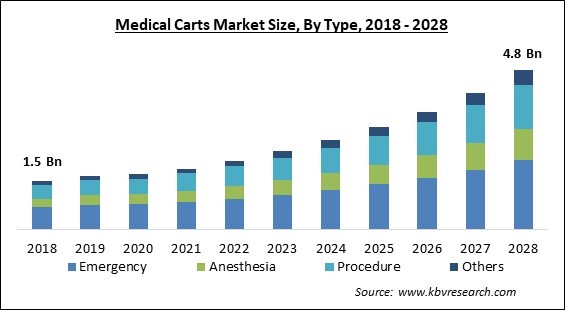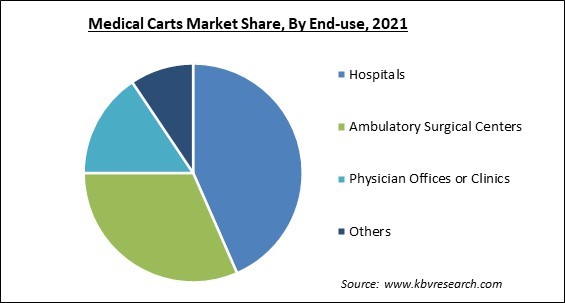The Global Medical Carts Market size is expected to reach $4.8 billion by 2028, rising at a market growth of 15.0% CAGR during the forecast period.
In healthcare facilities, medical carts are used to store and convey medications, medical supplies, as well as emergency equipment. Medical carts are simultaneously lightweight and sturdy. Medical carts, including isolation carts, crash carts, respiratory carts, and many others, can be customized for any eventuality. These customized carts are constructed from a variety of materials, such as stainless steel, health-grade PVC tubing, poly/aluminum, and even wood laminate.

Some of these medical carts may have storage bins, computers, laptops, and scanning gadget compartments. Utilizing premium medical carts, hospitals can keep all medical supplies organized. This also contributes to the enhancement of the efficiency of emergency rooms, hospitals, and trauma centers. These carts are useful for transferring pharmaceuticals, oxygen tanks, anesthetics, and medical equipment.
Convenient and well-organized medical carts provide secure access to drugs and other medical requirements when they are most needed. It increases staff efficiency and enhances patient care. The medical carts are designed to withstand the challenges of daily life and meet the requirements of every department within any healthcare industry.
Medical carts can be customized for any circumstance, including crash carts, respiratory carts, isolation carts, and a number of other purposes. Hospitals might utilize medical carts to organize their medicinal supplies. There are numerous kinds of medical carts, including emergency crash carts, anesthetic carts, operation carts, isolation carts, and medicine carts.
A mobile computer cart for medical use is more efficient than fixed computer workstations. Medical carts are mobile, allowing physicians, nurses, and other medical personnel to give prescriptions and check on several patients or residents during rounds. This can be accomplished without the need to visit a computer station after each patient or resident visit. Doctors, nurses, and care workers must traditionally share a computer to input or retrieve patient data at a central station. However, a medical cart with wheels improves data entry because more of it can be performed in the patient's room.
Medical carts on wheels of superior quality can improve the patient experience. Doctors, nurses, and care workers can enhance patient participation by being present during the evaluation of medical records. When medical and care personnel spend less time trying to access a shared, wall-mounted computer system, they may spend more time with patients and improve their bedside manner. Modern medical carts provide staff with direct access to a computer, enabling them to promptly make appointments or reply to patient inquiries.
One of the biggest challenges that are hampering the growth of the medical carts market is the increasing number of strict regulations all over the world. Healthcare is a very critical industry, which is required to be regulated. With an aging population and multiple malignant diseases necessitating lengthy hospital stays as well as routine medical care, hospitals are rapidly adopting medical carts with a variety of specialized features and technological developments.
Based on Product, the Medical Carts Market is segregated into Mobile Computing; Wall-Mounted Workstations; Medication; Storage Columns, Cabinets, & Accessories; and Others. In 2021, the wall-mounted workstations garnered a significant revenue share of the medical carts market. The growth of the segment is majorly owing to advantages, such as maximizing floor space and reducing the spread of infectious diseases. Increasing awareness among patients and healthcare workers regarding the use of computers in healthcare and MSDs promotes the demand for ergonomically sound solutions, including computer mounting systems.

On the basis of Type, the Medical Carts Market is segmented into Anesthesia, Emergency, Procedure, and Others. In 2021, the emergency segment procured the biggest revenue share of the medical carts market. The growth of the segment is rising because emergency carts are employed more commonly in emergency departments. As the risk of infectious diseases increases in emergency care units, the demand for these items is anticipated to rise in the coming years.
By End-use, the Medical Carts Market is classified into Hospitals, Ambulatory Surgical Centers, Physician Offices or Clinics, and Others. In 2021, the hospitals segment witnessed the highest revenue share of the medical carts market. Technological advances in medical mobile workstations drive their adoption. These developments include the introduction of customizable, secure, and effective medicine delivery devices. Increased emphasis on patient engagement as well as promotion of electronic health record (EHR) incentive programs in hospitals stimulate patient participation and can be contributed to the growth of this segment.
| Report Attribute | Details |
|---|---|
| Market size value in 2021 | USD 1.8 Billion |
| Market size forecast in 2028 | USD 4.8 Billion |
| Base Year | 2021 |
| Historical Period | 2018 to 2020 |
| Forecast Period | 2022 to 2028 |
| Revenue Growth Rate | CAGR of 15% from 2022 to 2028 |
| Number of Pages | 217 |
| Number of Tables | 389 |
| Report coverage | Market Trends, Revenue Estimation and Forecast, Segmentation Analysis, Regional and Country Breakdown, Companies Strategic Developments, Company Profiling |
| Segments covered | Product, Type, End-use, Region |
| Country scope | US, Canada, Mexico, Germany, UK, France, Russia, Spain, Italy, China, Japan, India, South Korea, Singapore, Malaysia, Brazil, Argentina, UAE, Saudi Arabia, South Africa, Nigeria |
| Growth Drivers |
|
| Restraints |
|
Region-Wise, the Medical Carts Market is analyzed across North America, Europe, Asia-Pacific, and LAMEA. In 2021, North America accounted for the biggest revenue share of the medical equipment market. Significant government investments in the development of novel medical devices, the presence of prominent market players, and the prevalence of a favorable reimbursement environment are the factors contributing to the expansion of the regional market.
Free Valuable Insights: Global Medical Carts Market size to reach USD 4.8 Billion by 2028
The market research report covers the analysis of key stake holders of the market. Key companies profiled in the report include Advantech Co., Ltd, McKesson Corporation (McKesson Medical-Surgical, Inc.), Medline Industries Inc., Capsa Healthcare LLC, Ergotron, Inc., ITD GmbH, Her go Ergonomic Support Systems, Inc., Enovate Medical, GCX Corporation, and JACO, Inc.
By Type
By Product
By End-use
By Geography
The global Medical Carts Market size is expected to reach $4.8 billion by 2028.
Increased Efficiency For The Healthcare Team Along With Reduced Errors are driving the market in coming years, however, Stringent Regulatory Framework For Commercialization Of The Product restraints the growth of the market.
Advantech Co., Ltd, McKesson Corporation (McKesson Medical-Surgical, Inc.), Medline Industries Inc., Capsa Healthcare LLC, Ergotron, Inc., ITD GmbH, Her go Ergonomic Support Systems, Inc., Enovate Medical, GCX Corporation, and JACO, Inc.
The Mobile Computing segment acquired maximum revenue share in the Global Medical Carts Market by Product in 2021 thereby, achieving a market value of $2.8 billion by 2028.
The North America market dominated the Global Medical Carts Market by Region in 2021, and would continue to be a dominant market till 2028; thereby, achieving a market value of $1.8 billion by 2028.
Our team of dedicated experts can provide you with attractive expansion opportunities for your business.

